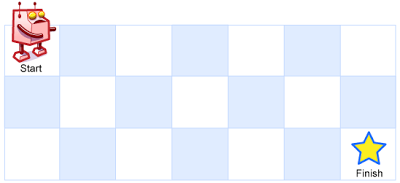g0001_0100.s0062_unique_paths.readme.md Maven / Gradle / Ivy
Go to download
Show more of this group Show more artifacts with this name
Show all versions of leetcode-in-java21 Show documentation
Show all versions of leetcode-in-java21 Show documentation
Java-based LeetCode algorithm problem solutions, regularly updated
62\. Unique Paths
Medium
A robot is located at the top-left corner of a `m x n` grid (marked 'Start' in the diagram below).
The robot can only move either down or right at any point in time. The robot is trying to reach the bottom-right corner of the grid (marked 'Finish' in the diagram below).
How many possible unique paths are there?
**Example 1:**

**Input:** m = 3, n = 7
**Output:** 28
**Example 2:**
**Input:** m = 3, n = 2
**Output:** 3
**Explanation:**
From the top-left corner, there are a total of 3 ways to reach the bottom-right corner:
1. Right -> Down -> Down
2. Down -> Down -> Right
3. Down -> Right -> Down
**Example 3:**
**Input:** m = 7, n = 3
**Output:** 28
**Example 4:**
**Input:** m = 3, n = 3
**Output:** 6
**Constraints:**
* `1 <= m, n <= 100`
* It's guaranteed that the answer will be less than or equal to 2 * 109.
To solve the "Unique Paths" problem in Java with the Solution class, follow these steps:
1. Define a method `uniquePaths` in the `Solution` class that takes two integers `m` and `n` as input and returns the number of unique paths from the top-left corner to the bottom-right corner of an `m x n` grid.
2. Initialize a 2D array `dp` of size `m x n` to store the number of unique paths for each position in the grid.
3. Initialize the first row and first column of `dp` to 1 since there is only one way to reach any position in the first row or column (by moving only right or down).
4. Iterate over each position `(i, j)` in the grid, starting from the second row and second column:
- Update `dp[i][j]` by adding the number of unique paths from the cell above `(i-1, j)` and the cell to the left `(i, j-1)`.
5. Return the value of `dp[m-1][n-1]`, which represents the number of unique paths to reach the bottom-right corner of the grid.
Here's the implementation of the `uniquePaths` method in Java:
```java
class Solution {
public int uniquePaths(int m, int n) {
int[][] dp = new int[m][n];
for (int i = 0; i < m; i++) {
dp[i][0] = 1; // Initialize first column to 1
}
for (int j = 0; j < n; j++) {
dp[0][j] = 1; // Initialize first row to 1
}
for (int i = 1; i < m; i++) {
for (int j = 1; j < n; j++) {
dp[i][j] = dp[i-1][j] + dp[i][j-1]; // Calculate number of paths for current cell
}
}
return dp[m-1][n-1]; // Return number of unique paths for bottom-right corner
}
}
```
This implementation efficiently calculates the number of unique paths using dynamic programming, with a time complexity of O(m * n) and a space complexity of O(m * n).